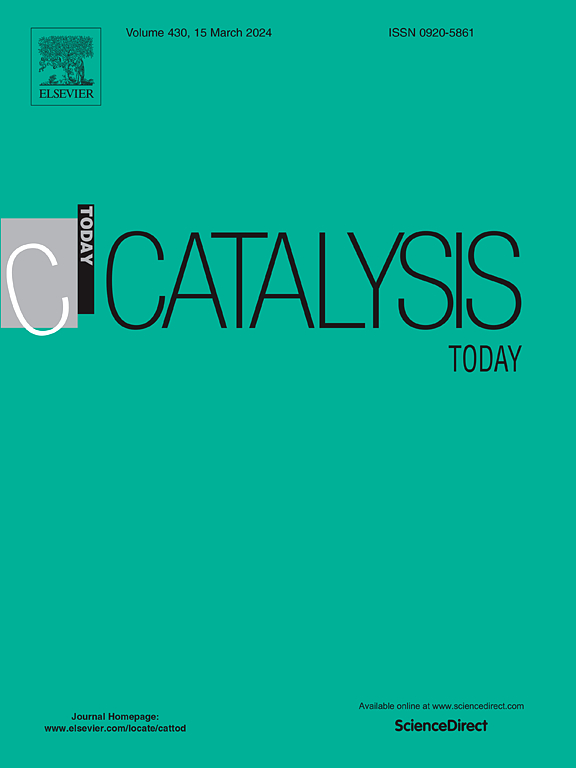层状双氢氧化物作为呋喃基聚酯合成的替代催化剂
IF 5.2
2区 化学
Q1 CHEMISTRY, APPLIED
引用次数: 0
摘要
开发合成呋喃基聚酯的替代系统对于实现可持续的生物基聚合物生产至关重要。在这项工作中,合成了含有替代二价(Zn2 +,Sn2+),三价(Sb3+)和四价(Ti4+)金属的层状双氢氧化物(LDHs),并将其用作催化剂,通过两段熔融聚合工艺生产聚呋喃酸乙烯(PEF)。x射线衍射数据显示了晶体结构的正确形成。对其催化性能进行了评价,并与传统金属催化剂进行了比较。Zn/Sn/Al-和Mg/Al/ ti -基LDHs是聚合反应的有效催化剂。有趣的是,市售的Mg/ al基水滑石提供了最高分子量的PEF。采用热重分析和差示扫描量热法测定了PEF的热性能。所有合成的聚酯都是无定形的,具有高Tg(83-87℃)。通过在不同的尺度上生产4 - 6碳二醇链长不同的呋喃基聚酯,证明了ldh基催化剂的可扩展性和通用性。通过IR和1H NMR证实了聚呋喃酸丁二烯(PBF)、聚呋喃酸戊二烯(PPeB)和聚呋喃酸己二烯(PHF)的生成。这些结果强调了LDHs作为推进绿色聚合技术的可持续催化剂的潜力。本文章由计算机程序翻译,如有差异,请以英文原文为准。
Layered double hydroxides as alternative catalysts for furan-based polyesters synthesis
The development of alternative systems for the synthesis of furan-based polyesters is essential for enabling sustainable and biobased polymer production. In this work, layered double hydroxides (LDHs) containing alternative divalent (Zn2 +, Sn2+), trivalent (Sb3+) and tetravalent (Ti4+) metals to the traditional Mg2+ and Al3+ were synthesized and employed as catalysts for the production of poly(ethylene furanoate) (PEF) through a two-stage melt polymerization process. The X-ray diffraction data of the LDHs indicate the correct formation of crystalline structure. The catalytic performance of the LDHs was evaluated and compared to that of conventional metal catalysts. Zn/Sn/Al- and Mg/Al/Ti-based LDHs were efficient catalysts in the polymerization reaction. Interestingly, commercially available Mg/Al-based hydrotalcite afforded PEF with the highest molecular weight. Thermal properties of PEF were determined by thermogravimetric analysis and differential scanning calorimetry. All the synthesised polyesters are amorphous, exhibiting high Tg (83–87 ºC). The scalability and versatility of LDH-based catalysts were demonstrated by producing furan-based polyesters at different scales and with varying diol chain lengths from 4 to 6 carbons. The formation of poly(butylene furanoate) (PBF), poly(pentylene furanoate) (PPeB), and poly(hexylene furanoate) (PHF) was confirmed by IR and 1H NMR. These results underscore the potential of LDHs as sustainable catalysts for advancing greener polymerization technologies.
求助全文
通过发布文献求助,成功后即可免费获取论文全文。
去求助
来源期刊

Catalysis Today
化学-工程:化工
CiteScore
11.50
自引率
3.80%
发文量
573
审稿时长
2.9 months
期刊介绍:
Catalysis Today focuses on the rapid publication of original invited papers devoted to currently important topics in catalysis and related subjects. The journal only publishes special issues (Proposing a Catalysis Today Special Issue), each of which is supervised by Guest Editors who recruit individual papers and oversee the peer review process. Catalysis Today offers researchers in the field of catalysis in-depth overviews of topical issues.
Both fundamental and applied aspects of catalysis are covered. Subjects such as catalysis of immobilized organometallic and biocatalytic systems are welcome. Subjects related to catalysis such as experimental techniques, adsorption, process technology, synthesis, in situ characterization, computational, theoretical modeling, imaging and others are included if there is a clear relationship to catalysis.
 求助内容:
求助内容: 应助结果提醒方式:
应助结果提醒方式:


